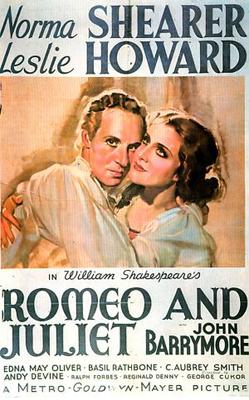Romeo
and Juliet (1936)
Directed by George Cukor
Screenplay by Talbot Jennings,
based on the play by William Shakespeare
Runtime: 2 hr, 5 min
Ah,
William Shakespeare. His plays have
delighted the multitudes, brought enlightenment to theatre-goers and confounded
high school English students for centuries.
It is no surprise, then, that the Bard’s works have been adapted many
times over for the big screen. And why
not, with dialogue larger than life, sword play aplenty, and the fact that all
of his works are in the public domain?
Yet there weren’t too many Shakespeare adaptations during Hollywood’s
golden age, making the 1936 version of Romeo
and Juliet a relatively unique specimen.
If
you don’t know the tragic tale of Romeo and Juliet, then welcome to Western
civilization. For all others, you know
the drill; “star-cross’d lovers” and all that entails. Here, we find Norma Shearer as Juliet of the
Capulet clan and Leslie Howard playing Romeo, a Montague. Their families hate each other but they fall
in love and get married. Only problem:
the universe is conspiring against them, and as the prologue tells us, they
commit suicide. Their deaths bring forth
reconciliation between the warring families, and the credits roll.
In
terms of adapting the text for the screen, this version does its job rather nicely. Screenwriter Talbot Jennings did cut some
scenes out, particularly comic relief sequences in the second half, but the
story itself is intact and is easy to follow.
In addition, the decision to show some of the offstage action is a
welcome addition. For example, this film
shows the messenger getting quarantined on the way to Mantua. While it does remove the textual suspense
regarding whether Romeo gets the message, it also makes the event more
believable and less of a plot convenience.
Furthermore,
the way in which the filmmakers use new medium is indeed inspired. One of the advantages of film is that the
director and the cinematographer can choose which part of the scene to focus on
at any given point. This is used to
great effect when Romeo first lays eyes on Juliet. The camera cuts between Juliet’s grand
entrance, complete with choir and dance, and Romeo’s mesmerized reaction. This sequence underscores the pivotal nature
of that first encounter, and similar scenes in the film have a very similar
nature.
All
that out of the way: let’s talk about the casting. The cast list to this film still has me
scratching my head. On paper it looks
excellent. Howard, best known for
playing Ashley Wilkes in Gone with the
Wind, is perfect for the part of Romeo, Basil Rathbone is a top-notch
choice for Tybalt, and they even got John Barrymore to play Mercutio. This tale of star-cross’d lovers merits a
star-studded cast, and that’s exactly what it got. The only problem was that this particular
adaptation was made in 1936.
Everyone,
and I do mean everyone, is far too old for their roles. Romeo, Juliet and their pals are
teenagers. That’s kind of why they act
so impulsively throughout the story. The
fact that Shearer, then in her early-thirties, is the closest to her
character’s age should tell you something.
This causes some massive incongruities in the characters’ actions. It is so jarring to see someone who is
clearly an adult trying to tap into the emotional immaturity of a 14-year
old. It’s as if the audience has entered
into a topsy-turvy world.
Still,
I could forgive the odd casting choices if the performances were good. But, well, they aren’t. Well, okay, most of them are passable, and
Rathbone was made to play a man such as Tybalt.
However, the train wrecks are far more vivid in this film. Most unfortunately, Barrymore is beyond
wretched as Mercutio. There’s no
liveliness to his mayhem and humor; he looks as though he’s simply going
through the motions. But we’re talking
about Mercutio, the guy cracking jokes as he lies dying. The result is a performance which is annoying
and boring simultaneously.
Granted,
some performances have memorable moments, such as Shearer’s contemplations and
fears before taking the sleeping potion.
But these problems with the performances prevent me as a viewer from
getting invested in the film. Who cares
that Mercutio is dead and all hell has broken loose as a result? Who cares that Romeo has been banished from
Verona? These guys have become
archetypal characters; it should not be so difficult to latch onto their
plight, yet this adaptation of Romeo and
Juliet finds a way.
I
really did have high hopes for this film, and had the casting department done
its job properly instead of simply grabbing at names, I could easily see this
film as a smashing success. There’s
weight to sets and the costuming; there’s the sense that Verona is an actual
city with hordes of citizens. It has all
of the trappings of a major production that a Shakespeare play deserves. As it stands, however, Romeo and Juliet as directed by George Cukor is a failure. Not one on the level of the Baz Luhrmann
version, but a failure nonetheless.

No comments:
Post a Comment